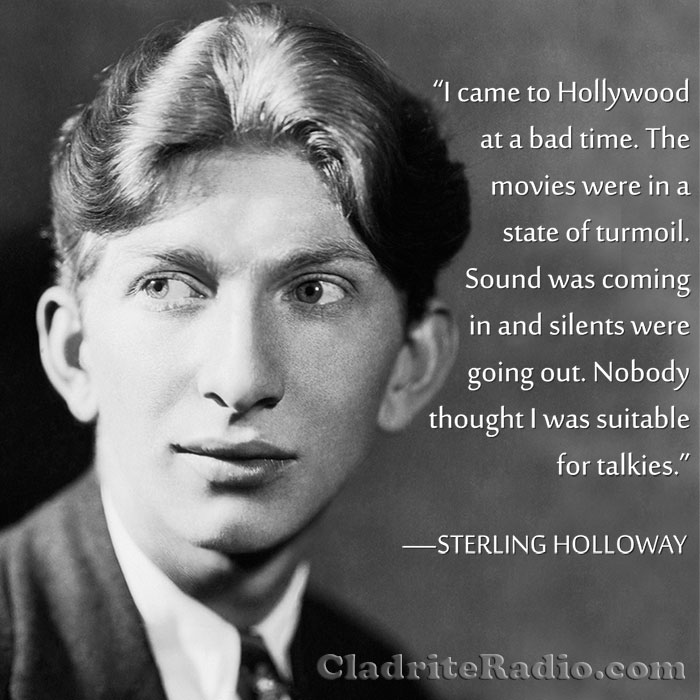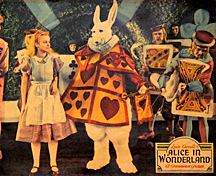Here are 10 things you should know about Whit Bissell, born 114 years ago today. The prolific character actor enjoyed success on Broadway, in pictures and on television.
Tag: Alice in Wonderland
10 Things You Should Know About Alison Skipworth
Here are 10 things you should know about Alison Skipworth, born 160 years ago today. The stage actress was 49 when she began her film career, but her screen legacy endures.
10 Things You Should Know About Ed Wynn
Here are 10 things to know about comedian Ed Wynn, born 133 years ago today. He enjoyed success in vaudeville, on Broadway, in radio, TV and movies.
Happy 112th Birthday, Sterling Holloway!
Character actor Sterling Holloway was born 112 years ago today in Cedartown, Georgia. Here are 10 SH Did-You-Knows:
- Holloway was the first of two sons born to grocer (and Cedartown mayor for one year when Sterling Jr. was seven years old) Sterling P. Holloway, Sr. and his wife, Rebecca.
- Holloway graduated from Georgia Military Academy in 1920 and though only 15, he immediately left the South for New York City to attend the American Academy of Dramatic Arts (Spencer Tracy was a classmate and friend).
- In his late teens, Holloway joined a touring company of The Shepherd of the Hills, performing in a series of one-nighters out west. Afterwards, he returned to NYC, where he performed small roles in Theatre Guild productions. He also was cast in the Rodgers and Hart review The Garrick Gaieties, in which he introduced the popular standard Manhattan.
- In 1926, Holloway moved to Hollywood to pursue a career in pictures, and he would go on to appear in 100 of them. His bushy red hair and prominent features made him a natural for comedies, and he got his start in silent pictures, appearing in three shorts and one feature (Casey at the Bat [1927]).
- In 1932, after four years without a film role (a director had reportedly told him he was “too repulsive” for silent pictures), Holloway began to work in talkies, where his high-pitched, chalky voice served him well, and he kept very busy indeed. From 1932-35, he averaged 10 pictures (some of them short subjects) a year.
- Over the course of his 50-year, Holloway appeared in (or did voice work for) more than 100 features and shorts, and made nearly as many television appearances.
- In addition to his picture and television work, Holloway worked frequently on radio, a medium to which his unique and memorable voice was well-suited. Among the shows to which Holloway lent his talents were The Railroad Hour, The United States Steel Hour, Suspense, Lux Radio Theater and Fibber McGee and Molly.
- Holloway was one of the first actors to make the jump to television, appearing in 1949 on the anthology series Your Show Time, which featured half-hour adaptaions of literary short stories from the likes of Sir Arthur Conan Doyle, Henry James and Robert Louis Stevenson. It was the first American dramatic series to be shot on film and the first series to win an Emmy award.
- Holloway frequently did voice work for animated features, including Dumbo (1941), Bambi (1942), Alice in Wonderland (1951), The Jungle Book (1967), The Aristocats (1970) and perhaps most famously, he provided the voice of Winnie the Pooh in Disney’s popular series of Pooh featurettes.
- College Street, where the Holloway family resided in Cedartown, is now called Sterling Holloway Place and there’s a plaque at the site of his boyhood home.
Happy birthday, Sterling Holloway, wherever you may be!

Just mad about Alice
 We’ll likely get around to catching Tim Burton’s new take on Alice in Wonderland eventually, but what we’re really excited about is the new DVD release of the 1933 version of Lewis Carroll’s classic work.
We’ll likely get around to catching Tim Burton’s new take on Alice in Wonderland eventually, but what we’re really excited about is the new DVD release of the 1933 version of Lewis Carroll’s classic work.
Directed by Norman McLeod with the invaluable creative input of art director, William Cameron Menzies, this Paramount release boasted a impressive roster of 1930s stars, among them Gary Cooper, Cary Grant, Mae Marsh, W.C. Fields, Edna May Oliver, Richard Arlen, May Robson, Sterling Holloway, Edward Everett Horton, Polly Moran, Charles Ruggles, and Ned Sparks.
Dave Kehr of The New York Times wrote of the Paramount Alice, “Seen today, it’s still a profoundly creepy experience. This Wonderland is not the proto-psychedelic playground of the 1951 Disney animated version, but a distorted, claustrophobic environment populated by menacing, bizarre figures.”
Kehr goes on to say, regarding the movie’s special effects, “As dazzling as today’s digital effects can be (and Mr. Burton’s Cheshire Cat is sure to be memorable), we remain all too aware of how they are accomplished (computers!) for them to possess the seductive sense of mystification that Menzies and McLeod achieve here, using practical techniques derived from Victorian stage magic.”
We couldn’t agree more. We have just about had our fill of today’s CGI effects — give us some old-fashioned, hand-crafted movie magic.
The 1933 Alice also has the exclusive distinction of having garnered an enthusiastic thumb’s-up from the very woman who, as a young girl, inspired Carroll’s stories.
As Kehr writes…
In a Jan. 7, 1934, article in the Times, Alice Liddell, quoted under her married name, Mrs. Reginald Hargreaves, expressed admiration for the film that Hollywood had wrought from the story Carroll had invented for her some seven decades before.
“I am delighted with the film and am now convinced that only through the medium of the talking picture art could this delicious fantasy be faithfully interpreted,” she declared, her words possibly burnished by a Paramount publicist. “‘Alice’ is a picture which represents a revolution in cinema history!”
That’s good enough for us! Our copy of the dvd is already on order and will soon be winging its way to us.
Mr. Burton’s picture may just have to wait a while for our patronage, while we savor a 1930s classic.
